
- Stellar gaming experience
- Perfect black levels
- Solid SDR color accuracy
- Multiple OLED care features
- Low brightness
- Struggles in desktop use
For the past couple of years, OLED has struggled to find a place among the best gaming monitors, but LG’s UltraGear OLED 45 feels uniquely positioned for high-end PC gaming. Its massive size and aggressive curve provide one of the most immersive gaming experiences money can buy, and the OLED panel ensures excellent colors and contrast.
You won’t find a better monitor for cinematic games, but outside of that realm, the UltraGear OLED 45 starts to struggle. The curve makes it a tough sell for basic desktop use, as does the low pixel density — but this is a display built for gaming, and it does a great job at that, even if it comes at the sacrifice of other use cases.
Video review
LG UltraGear OLED 45 (45GR95QE-B) specs
| LG UltraGear OLED 45 (45GR95QE-B) | |
| Screen size | 44.5 inches |
| Panel type | OLED |
| Resolution | 3,440 x 1,440 |
| Peak brightness | 200 nits (SDR), 1,000 nits (HDR) |
| HDR | Yes |
| Local dimming | 4,953,600 zones |
| Contrast ratio | 1,500,000:1 |
| Response time | 0.03ms (GtG) |
| Refresh rate | 240Hz |
| Curve | 800R |
| Speakers | N/A |
| Inputs | 1x DisplayPort 1.4, 2x HDMI 2.0 |
| Ports | 2x USB 3.2 Gen 1 Type-A, 3.5mm headphone |
| Adjustments | 20 degrees swivel, 20 degree tilt, 4.3 inches height |
| List price | $1,700 |
Massive is an understatement
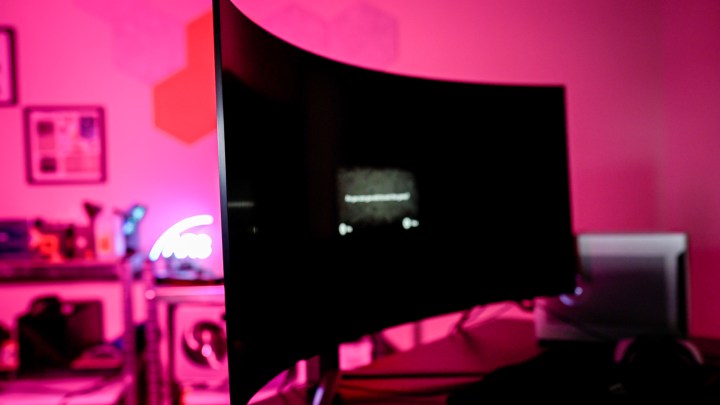
It’s hard to overstate just how big the UltraGear OLED 45 really is. It’s a 44.5-inch monitor with a 21:9 aspect ratio, but its footprint is multiplied due to the steep 800R curve. Even compared to a display like the Asus ROG PG42UQ, the UltraGear OLED 45 feels massive.
That’s not a bad thing, as the size and curve fully immerse you in games. The point remains, however, that you’ll need a lot of desk space. The monitor is about 29 inches wide, and over 25 inches tall at its highest point. Thankfully, a standard 100mm x 100mm mount is available on the back, so you can wall-mount it.

Throwing the UltraGear OLED 45 on a mount isn’t a bad idea, as the included stand doesn’t have a ton of room for adjustment.
This isn’t the Samsung Ark, where you can rotate the display fully vertical. Instead, you’re given a restrictive range of 20 degrees of swivel and tilt for minor adjustments, though thankfully, there’s a generous 4.3 inches of height adjustment.

Outside of ergonomics, the UltraGear OLED 45 looks fantastic. It features LG’s signature UltraGear vents on the back, which illuminate light from the back of the display. You have a few options for colors, as well as a rainbow cycle setting in the menu. LG describes the screen as “virtually borderless,” and although there is a thin bezel, the actual frame barely peaks out around the edge of the display.
The monitor looks amazing, and if you’re positioned correctly, there’s nothing that provides quite the same gaming experience. My main problem is the lack of versatility of this design. It’s a bad option for basic desktop use due to the aggressive curve, and it’s tough to get engrossed in movies due to the bowing around the curve when you’re sitting too far back.
A dilemma between monitor and TV
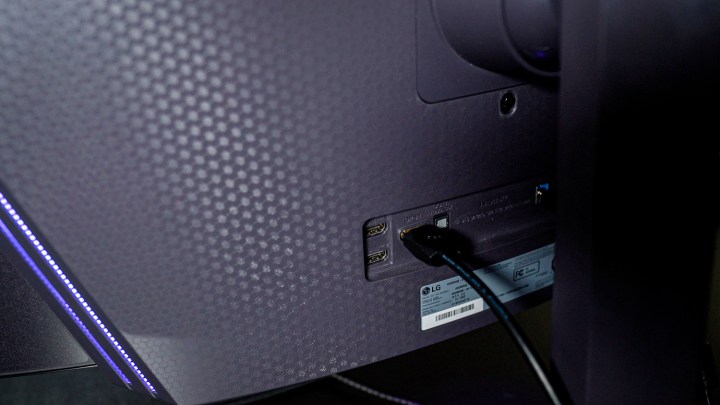
The LG OLED 45 has a standard array of ports — two HDMI 2.1 and a single DisplayPort 1.4 for inputs, along with two USB 3.2 Gen 1 connections through the built-in USB hub. Like most LG monitors, the ports are around the back of the display, rather than underneath like on the Samsung Odyssey Neo G8. That means the connections stick out a bit, but with a monitor this large, it’s hardly an issue.
What isn’t standard is the audio. You have access to a headphone jack that supports DTS Headphone:X virtual surround sound directly under the front of the display, which is super handy. You also have access to an optical audio jack behind the monitor. Although the UltraGear OLED 45 unfortunately doesn’t include built-in speakers, it’s easy enough to hook up a pair of PC speakers or a soundbar.
Ports are great, but I have a bone to pick with controlling the monitor. Just like the UltraGear OLED 27, you have to use the included remote in order to access the on-screen display (OSD). There’s a standard array of settings, including a few color profiles, but you can’t access the full menu without the remote.
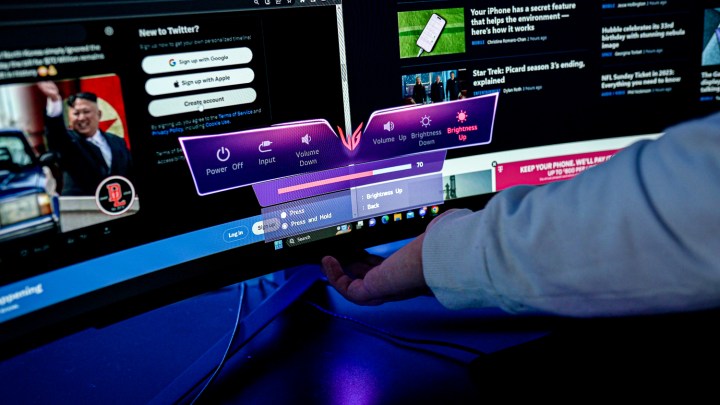
Instead, a button on the bottom of the display pulls up a quick access menu where you can quickly adjust the brightness, turn off the monitor, and swap inputs. The problem is that this is just a button, so there are situations where you’ll have to press it a few dozen times just to turn down the brightness a bit.
When I looked at the 27-inch model, I had problems with a screw covering the battery slot for the remote, which also applies here. The larger issue here, though, is that there’s no way to control the monitor apart from the remote, and it’s annoying and time-consuming to painstakingly click through the quick access menu.
Low brightness, world-class image
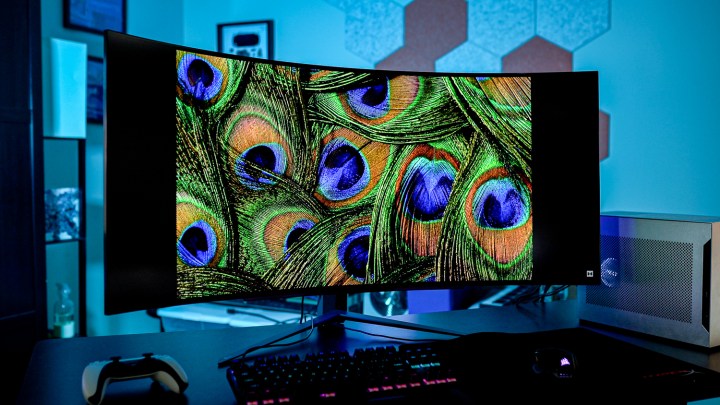
There’s no doubt that OLED provides one of the best pictures you can get out of a monitor right now. Wide color coverage, perfect black levels, and pixels that control their own brightness leads to an image that’s vibrant and moody, speeding past most LCDs. The UltraGear OLED 45 isn’t different, is entering a market that’s starting to fill up, and it comes with its own set of issues.
For starters, it’s dim. Similar to the UltraGear OLED 27, this monitor tops out at around 200 nits of brightness. With a 3% window, LG claims up to 1,000 nits, but I only measured 780. Low brightness is typical of OLED, and although some may cry foul at a notion of a dimmer monitor, it was never too dim for me to work on during testing.
No, low brightness introduces issues that have nothing to do with being able to see the display. At lower brightness settings, whites don’t appear white, instead being shadowed in a clear gray color. I would have to turn the monitor up to around 75% brightness to even get whites to actually look white. For most of my testing, the monitor was locked at 100% brightness.
Dim as it is, there’s no doubt that the LG UltraGear OLED 45 is beautiful. It has an extended color range, and I measured 96% of DCI-P3 in my testing. It clocked in with a color error of 1.5 in SDR. That’s far better than some other OLED panels I’ve tested, like the Asus ROG PG27AQDM, though the LG OLED 45 showed a noticeable bump in yellows.
As we’ve seen in the past, HDR is where the color accuracy falls apart. It’s way off out of the box, but that doesn’t mean the monitor looks bad. This is clearly a monitor built for consumption, not creation. You can do a bit of color work in SDR, but I wouldn’t do anything serious. It’s built for watching movies and playing games, and it does an exceptional job at both.
Assuming you crank up the brightness, there’s only one issue with the image quality: pixel density. This is a 44.5-inch display with a resolution of 3,440 x 1,440, leading to a pixel density of around 83 pixels per inch (PPI). That’s around the same level as a 27-inch 1080p monitor, and it’s a big reason why a display like the LG UltraGear OLED 48 is hard to justify.
It doesn’t look nearly as sharp as something like the Alienware 34 QD-OLED due to the fact that it’s much larger. Normally, you’d solve that by sitting further back from the monitor, but with the aggressive 800R curve, you’re clearly meant to be right in the action with this display. It’s hard to spot the rough edges while playing a game or kicking back and watching a movie, but for browsing and looking at text, the screen isn’t super sharp.
As with any OLED panel, it’s important to mention a few disclaimers here. There’s always a small risk of OLED burn-in, though the hysteria surrounding OLED burn-in is a bit overblown. I didn’t have the slightest hint of image retention during my testing, and the UltraGear OLED 45 will automatically dim after a few minutes of inactivity.
There also are several panel-saving features. LG includes an automatic screensaver, along with a pixel-cleaning function to keep your panel looking clear.
The cinematic gaming champ
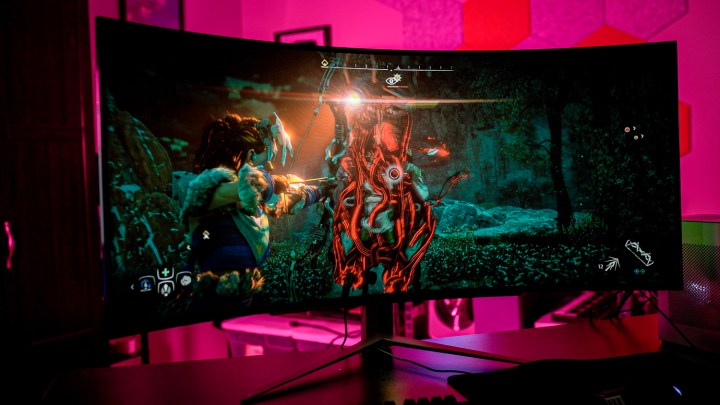
There’s only one word to describe the UltraGear OLED 45 when it comes to gaming: immersive. The 800R curve is super-aggressive, but it envelopes you in the experience of playing, and it’s hard to pull away once you’re sucked into a game. This is a display built for blockbuster, cinematic games, and it does a fantastic job at that.
It’s not the same as other OLEDs I’ve reviewed, though. Similar to LG’s 27-inch model and Asus’ OLED rival, this monitor comes with a 240Hz refresh rate. And due to using an OLED panel, it has very low response times. That leads to exceptional motion clarity, which is great if you play competitive games like Overwatch 2 and Valorant.
Although that’s true on paper, I wouldn’t recommend the UltraGear OLED 45 for these types of games. With the 21:9 aspect ratio, massive size, and steep curve, playing a competitive title always felt wrong. There was always too much screen to take in everything at once, regardless of how great the motion clarity really is.
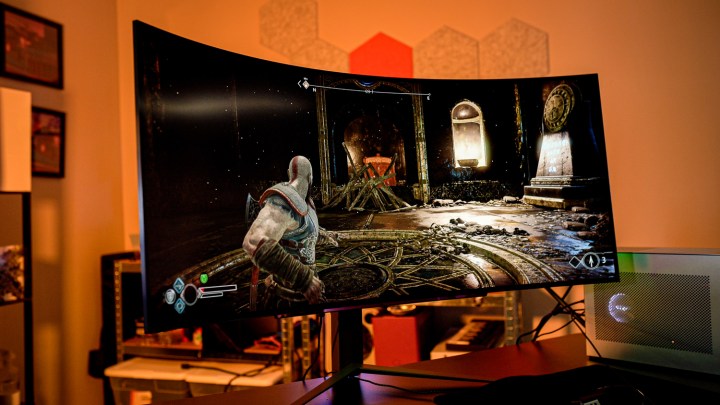
Where the UltraGear OLED 45 shines is in single-player experiences. Games like Cyberpunk 2077, Marvel’s Spider-Man, and Horizon Zero Dawn all look fantastic, and due to how large the monitor is, you feel like you’re getting sucked into the world. If I had the UltraGear OLED 45 set up for single-player games, I’m not sure I’d ever leave my desk.
Outside of immersion and excellent HDR, the UltraGear OLED 45 has a couple of perks for gaming. For starters, it’s G-Sync Compatible and certified with FreeSync Premium, so you’re getting variable refresh rate regardless of if you have an AMD or Nvidia GPU. In addition, it comes with a headphone jack on bottom that support DTS Headphone:X for virtual surround sound. You can get virtual surround sound by plugging your headset into your PC, but having the port right under the monitor is handy. LG even includes a few profiles tailored to gaming or watching movies.
A gamer’s monitor
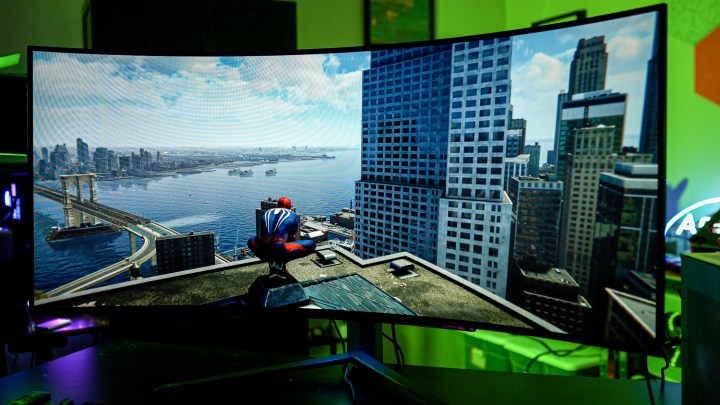
When the UltraGear OLED 45 is operating at full tilt, there’s nothing like it. The gaming experience for cinematic titles is engrossing, and you won’t want to stop playing. Outside of that boundary, though, the display becomes a lot less practical.
It’s tough recommending it for general desktop or work use due to the massive size and OLED panel, and although the size would normally make a good option for movies, the aggressive curve and specific viewing distance can kill the mood. There are also some issues with pixel density, with an ultrawide like the Alienware 34 QD-OLED offering much better clarity despite sporting the same resolution.
Even with those problems, the UltraGear OLED 45 shoots past displays like the Samsung Odyssey Neo G9 in games, providing an immersive gaming experience that other displays can’t keep up with.
Editors' Recommendations
- 3 upcoming gaming monitors worth getting excited about
- A key detail about LG’s OLED gaming monitor is still unknown
- LG’s first gaming laptop comes with some high-end specs
- LG claims new 27-inch UltraGear is world’s fastest 4K gaming monitor
- LG’s UltraGear monitors are blazingly fast, with a 1ms response time





